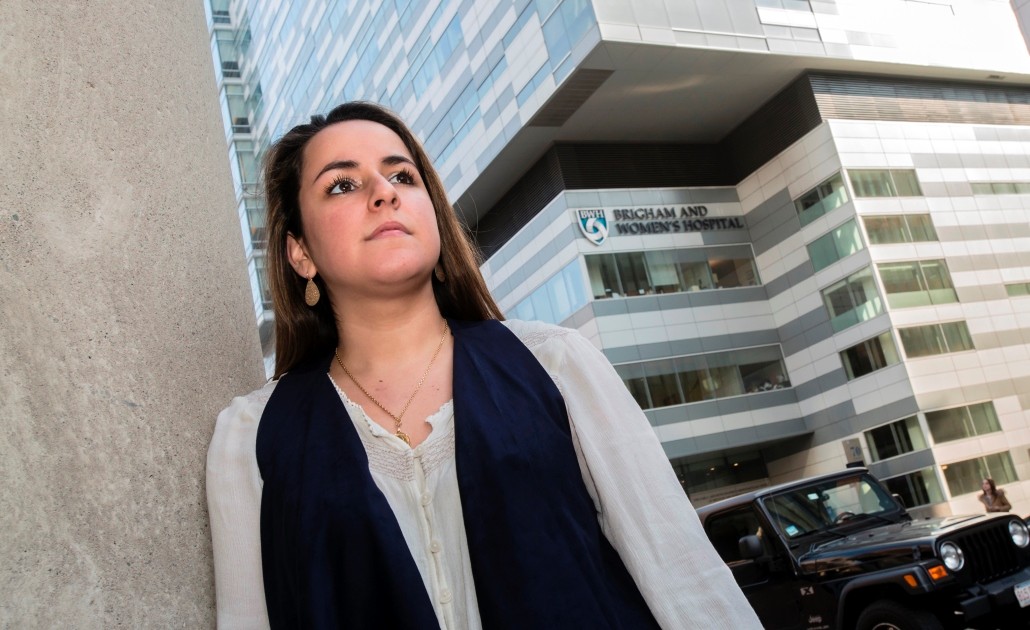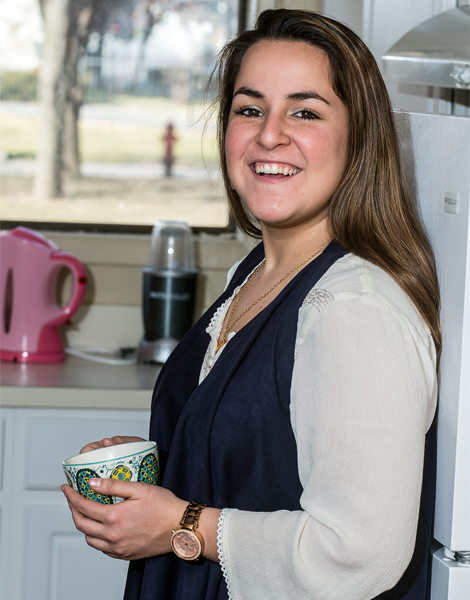
Senior Alessandra Maldonado, who spent her Spring Break donating bone marrow to help save the life of a three-year-old child, now seeks to encourage more people to join the national registry. (Photo by Lee Pellegrini)
As many members of the Class of 2016 look forward to their post-graduation lives, Alessandra Maldonado has an additional hope on her horizon: to learn that she has helped to save the life of a three-year-old child.
In early March, Maldonado spent part of her spring break at Boston’s Brigham and Women’s Hospital, donating her bone marrow to a little boy suffering from acute lymphoblastic leukemia, a rare cancer of the blood and bone marrow that affects white blood cells.
Everything went well, Maldonado said at the time. "The doctor said it was a fantastic procedure. The amount of marrow they typically extract is 24 healthy cells, but my body was able to yield 38 healthy cells, which is incredible."
The doctor told her that amount of cells would give the boy a better chance, but some two months later Maldonado heard the bad news: the procedure didn't work, and she would be needed again: this time to donate peripheral stem cells.
"They are hoping that my stem cells will stick this time," she said. "He is in a very critical state."
Hope is all Maldonado can do at this point, since it will be some time before she learns the outcome. "I unfortunately won't know about that for a very long time," she said. "It definitely has been occupying my mind. I think about what his parents must be going through all the time.
"I just want him to have a chance at living a healthy and happy life."
Since the first transplant, Maldonado—an English major in the Morrissey College of Arts and Sciences who has been accepted to several law schools—has been using her experience to help raise awareness about both the procedure itself and the need for more donors.
After the first donation, she spent a few days recovering in a hotel room near the hospital with her parents by her side before returning to campus. While the transplant itself isn’t particularly invasive, she said, the recovery can be quite uncomfortable and lengthy.
“I definitely felt the pain and soreness but it was totally worth it,” she said. “It’s completely unparalleled with anything else that I could ever do. Donating a piece of myself feels different. It’s a tremendous opportunity to help somebody who needs it.”
Everyone was asking about the procedure, she added. "It was surprising to hear how many people had questions about the whole experience. I've met people who have been affected by cancer, and they were especially grateful. So many students from the Connell School of Nursing came up to me and expressed their thoughts about it, which honestly felt so nice," she said. "All of my friends have been extremely supportive as well."
Despite the support she has received, Maldonado is of two minds about the attention she has drawn for her act of kindness. "The crazy thing is that I wasn't going to tell anyone about it," she said, "until I felt that I had a duty to raise awareness about the safety of the procedure and the need for more people to join the national bone marrow registry."
Maldonado joined the registry through the Gift of Life Bone Marrow Foundation during her freshman year, when Cancer Affects Siblings Too conducted a drive on campus. It wasn’t until last fall when she was notified that she was a match.
“I was a little nervous but ultimately overjoyed,” said Maldonado. “It’s not common to be a match for somebody else, and it was incredible to know that the three-year-old boy has my same genetic makeup.”

But Maldonado began her emotional rollercoaster when, earlier in the year, she received another call telling her the boy wasn’t stable enough to undergo the procedure.
“It was heartbreaking,” she said. “But then two weeks later, I received notice that the boy was indeed stable enough to receive the transplant. When I heard that, I was even more willing to donate.”
The decision to follow through with the bone marrow donation, however, was of great concern to Maldonado’s parents, who were unfamiliar with the procedure.
“It was a shock to them and was something completely unprecedented,” said Maldonado, a native of Peru. “Sure, they are very familiar with American medicine and the fact that we have the best medical facilities in the world, but when it comes to your child doing something that’s out of the blue and fairly uncommon, it warrants a very worried response. Every surgery has a risk, so for me to be taking on a small risk for somebody I don’t even know didn’t really make any sense to my parents.”
But after talking to others and receiving reassurance from medical professionals, her parents flew up to Boston to be at their daughter’s side.
“Having them behind me and having them talk to the doctor with specific questions I wouldn’t have thought to ask—about the anesthesia, and the procedure itself—was very reassuring. Having medical professionals walk my parents and me through the process and have them understand that this is very safe and routine really put my parents’ minds at ease.
“My mom and dad were able to understand why I was doing it and see that for me, this was a very, very good decision.”
Maldonado follows in the footsteps of 2015 graduate Kayla Hammergren, who in her senior year donated her marrow to help four-year-old James Strejc conquer leukemia. Hammergren met James last April at the inaugural Walk for Life at the Chestnut Hill Reservoir, and Maldonado hopes she’ll have a similar experience someday.
“Holistically, I feel really good about it. I’m just very happy that I was able to do something like this. I sincerely feel in my heart that this is the right thing to do for somebody who really needs me.”
Like Hammergren, Maldonado also hopes she can serve as an example for others to literally give of themselves and save a life.
“For many families, the donation of bone marrow to fight blood cancer is their best option. The idea is that my bone marrow will begin to generate healthy cells for the little boy once the marrow is inserted into his body. This is his chance of being saved.”
Maldonado has a message too: More minorities are needed for the national bone marrow registry.
“Since there are a lot of Caucasian people on the registry, Caucasian people have a greater chance of finding a match. Unfortunately, a lot of South American people are unfamiliar with the bone marrow procedure. The message that I want to get across is that it’s a very, very safe procedure, and it starts with joining the registry and hopefully one day being a match for somebody. This is a relatively routine thing, and if you’re a healthy person, everybody should consider donating because you really are saving someone’s life.
"The whole experience has also made me reflect on how fortunate I am to be healthy. To put it simply, cancer sucks, and it's unfortunate that so many families have to undergo that reality."
By Sean Hennessey | News & Public Affairs



